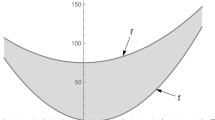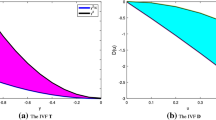Abstract
In this paper, we attempt to propose Ekeland’s variational principle for interval-valued functions (IVFs). To develop the variational principle, we study a concept of sequence of intervals. In the sequel, the idea of gH-semicontinuity for IVFs is explored. A necessary and sufficient condition for an IVF to be gH-continuous in terms of gH-lower and upper semicontinuity is given. Moreover, we prove a characterization for gH-lower semicontinuity by the level sets of the IVF. With the help of this characterization result, we ensure the existence of a minimum for an extended gH-lower semicontinuous, level-bounded and proper IVF. To find an approximate minima of a gH-lower semicontinuous and gH-Gâteaux differentiable IVF, the proposed Ekeland’s variational principle is used.
Similar content being viewed by others
Notes
Analytical models of some interesting real-world problems with neither differentiable nor continuous objective functions can be found in Clarke’s book Clarke (1990)
References
Ahmad I, Jayswal A, Al-Homidan S, Banerjee J (2019) Sufficiency and duality in interval-valued variational programming. Neural Comput Appl 31(8):4423–4433
Borwein JM, Mordukhovich BS, Shao Y (1999) On the equivalence of some basic principles in variational analysis. J Math Anal Appl 229(1):228–257
Burke J, Deng S (2002) Weak sharp minima revisited part I: basic theory. Control Cybern 31:439–469
Burke JV, Ferris MC (1993) Weak sharp minima in mathematical programming. SIAM J Control Optim 31(5):1340–1359
Chalco-Cano Y, Lodwick WA, Rufián-Lizana A (2013) Optimality conditions of type KKT for optimization problem with interval-valued objective function via generalized derivative. Fuzzy Optim Decis Mak 12(3):305–322
Chalco-Cano Y, Rufián-Lizana A, Román-Flores H, Jiménez-Gamero MD (2013) Calculus for interval-valued functions using generalized Hukuhara derivative and applications. Fuzzy Sets Syst 219:49–67
Chen SH, Wu J, Chen YD (2004) Interval optimization for uncertain structures. Finite Elem Anal Des 40(11):1379–1398
Clarke FH (1990) Optimization and Nonsmooth Analysis. Classics in Applied Mathematics, vol. 5. SIAM
Clarke FH (1976) The maximum principle under minimal hypotheses. SIAM J Control Optim 14(6):1078–1091
Ekeland I (1974) On the variational principle. J Math Anal Appl 47(2):324–353
Ekeland I (1979) Nonconvex minimization problems. Bull Am Math Soc 1(3):443–474
Fabian M, Mordukhovich BS (1998) Nonsmooth characterizations of Asplund spaces and smooth variational principles. Set-Valued Var Anal 6(4):381–406
Fabian M, Hájek P, Vanderwerff J (1996) On smooth variational principles in Banach spaces. J Math Anal Appl 197(1):153–172
Facchinei F, Pang JS (2007) Finite-Dimensional Variational Inequalities and Complementarity Problems. Springer Series in Operations Research, vol. 1. Springer Science & Business Media
Georgiev PG (1988) The strong Ekeland variational principle, the strong drop theorem and applications. J Math Anal Appl 131(1):1–21
Ghosh D (2017) Newton method to obtain efficient solutions of the optimization problems with interval-valued objective functions. J Appl Math Comput 53(1–2):709–731
Ghosh D, Ghosh D, Bhuiya SK, Patra LK (2018) A saddle point characterization of efficient solutions for interval optimization problems. J Appl Math Comput 58(1–2):193–217
Ghosh D, Singh A, Shukla KK, Manchanda K (2019) Extended Karush-Kuhn-Tucker condition for constrained interval optimization problems and its application in support vector machines. Inform Sci 504:276–292
Ghosh D, Debnath AK, Pedrycz W (2020) A variable and a fixed ordering of intervals and their application in optimization with interval-valued functions. Int J Approx Reason 121:187–205
Ghosh D, Chauhan RS, Mesiar R, Debnath AK (2020) Generalized Hukuhara Gâteaux and Fréchet derivatives of interval-valued functions and their application in optimization with interval-valued functions. Inform Sci 510:317–340
Gong D, Sun J, Miao Z (2016) A set-based genetic algorithm for interval many-objective optimization problems. IEEE Trans Evol Comput 22(1):47–60
Henrion R, Outrata J (2001) A subdifferential condition for calmness of multifunctions. J Math Anal Appl 258(1):110–130
Ishibuchi H, Tanaka H (1990) Multiobjective programming in optimization of the interval objective function. Eur J Oper Res 48(2):219–225
Kruger AY (2003) On Fréchet subdifferentials. J Math Sci 116(3):3325–3358
Kulisch UW, Miranker WL (1981) Computer arithmetic in theory and practice
Lupulescu V (2015) Fractional calculus for interval-valued functions. Fuzzy Sets Syst 265:63–85
Markov S (2000) On the algebraic properties of convex bodies and some applications. J Convex Anal 7(1):129–166
Moore RE (1966) Interval Analysis, vol 4. Prentice-Hall Englewood Cliffs, NJ
Osuna-Gómez R, Hernández-Jiménez B, Chalco-Cano Y, Ruiz-Garzón G (2017) New efficiency conditions for multiobjective interval-valued programming problems. Inform Sci 420:235–248
Penot JP (1986) The drop theorem, the petal theorem and Ekeland’s variational principle. Nonlinear Anal 10(9):813–822
Singh D, Dar BA, Kim D (2016) KKT optimality conditions in interval valued multiobjective programming with generalized differentiable functions. Eur J Oper Res 254(1):29–39
Stefanini L, Bede B (2009) Generalized Hukuhara differentiability of interval-valued functions and interval differential equations. Nonlinear Anal 71(3–4):1311–1328
Van Hoa N (2015) The initial value problem for interval-valued second-order differential equations under generalized H-differentiability. Inform Sci 311:119–148
Van Su T, Dinh DH (2020) Duality results for interval-valued pseudoconvex optimization problem with equilibrium constraints with applications. Comput Appl Math 39(2):1–24
Wolfe M (2000) Interval mathematics, algebraic equations and optimization. J Comput Appl Math 124(1–2):263–280
Wu HC (2007) The Karush-Kuhn-Tucker optimality conditions in an optimization problem with interval-valued objective function. Eur J Oper Res 176(1):46–59
Wu HC (2008) On interval-valued nonlinear programming problems. J Math Anal Appl 338(1):299–316
Wu HC (2008) Wolfe duality for interval-valued optimization. J Optim Theory Appl 138(3):497–509
Zhang Z, Wang X, Lu J (2018) Multi-objective immune genetic algorithm solving nonlinear interval-valued programming. Eng Appl Artif Intell 67:235–245
Acknowledgements
The authors put a sincere thanks to the reviewers and editors for their valuable comments to enhance the paper. The first author is grateful to the Department of Science and Technology, India, for the award of ‘inspire fellowship’ (DST/INSPIRE Fellowship/2017/IF170248). Authors extend sincere thanks to Prof. José Luis Verdegay, Universidad de Granada, for his valuable comments to improve quality of the paper.
Author information
Authors and Affiliations
Corresponding author
Additional information
Publisher's Note
Springer Nature remains neutral with regard to jurisdictional claims in published maps and institutional affiliations.
Appendices
A proof of Lemma 2.1
Proof of (i)
Let \({\textbf {A}}=[\underline{a},\overline{a}]\) and \({\textbf {B}}=[\underline{b},\overline{b}].\) Then,
We now have the following two possible cases.
-
Case 1. \(\Vert {\textbf {A}}\oplus {\textbf {B}}\Vert _{I(\mathbb {R})}=|\underline{a}+\underline{b}|.\) Since \(|\underline{a}+\underline{b}|\le |\underline{a}|+|\underline{b}|\le \max \{|\underline{a}|,|\overline{a}|\}+\max \{|\underline{b}|,|\overline{b}|\}=\Vert {\textbf {A}}\Vert _{I(\mathbb {R})}+\Vert {\textbf {B}}\Vert _{I(\mathbb {R})},\) we get \(\Vert {\textbf {A}}\oplus {\textbf {B}}\Vert _{I(\mathbb {R})}\le \Vert {\textbf {A}}\Vert _{I(\mathbb {R})}+\Vert {\textbf {B}}\Vert _{I(\mathbb {R})}.\)
-
Case 2. \(\Vert {\textbf {A}}\oplus {\textbf {B}}\Vert _{I(\mathbb {R})}=|\overline{a}+\overline{b}|.\) Since \(|\overline{a}+\overline{b}|\le |\overline{a}|+|\overline{b}|\le \max \{|\underline{a}|,|\overline{a}|\}+\max \{|\underline{b}|,|\overline{b}|\}=\Vert {\textbf {A}}\Vert _{I(\mathbb {R})}+\Vert {\textbf {B}}\Vert _{I(\mathbb {R})},\) therefore, \(\Vert {\textbf {A}}\oplus {\textbf {B}}\Vert _{I(\mathbb {R})}\le \Vert {\textbf {A}}\Vert _{I(\mathbb {R})}+\Vert {\textbf {B}}\Vert _{I(\mathbb {R})}.\)
Hence, \(\Vert {\textbf {A}}\oplus {\textbf {B}}\Vert _{I(\mathbb {R})}\le \Vert {\textbf {A}}\Vert _{I(\mathbb {R})}+\Vert {\textbf {B}}\Vert _{I(\mathbb {R})}~\text {for all}~{\textbf {A}},~{\textbf {B}}\in I(\mathbb {R}).\) \(\square \)
Proof of (ii)
Let \({\textbf {A}}=[\underline{a},\overline{a}],~{\textbf {B}}=[\underline{b},\overline{b}],~{\textbf {C}}=[\underline{c},\overline{c}]\) and \({\textbf {D}}=[\underline{d},\overline{d}]\). We note that
Also,
Thus, \({\textbf {A}}\oplus {\textbf {B}}\preceq {\textbf {C}}\oplus {\textbf {D}}\). \(\square \)
Proof of Lemma 2.2
Proof of (i)
Let \({\textbf {A}}=[\underline{a},\overline{a}],~{\textbf {B}}=[\underline{b},\overline{b}]\) and \(\epsilon >0.\) \({\textbf {A}}\ominus _{gH}{} {\textbf {B}}=[\underline{a}-\underline{b},\overline{a}-\overline{b}]\) or \([\overline{a}-\overline{b}, \underline{a}-\underline{b}].\) Let us now consider the following four possible cases.
-
Case 1. \({\textbf {A}}\ominus _{gH}{} {\textbf {B}}=[\underline{a}-\underline{b},\overline{a}-\overline{b}]\) and \(\Vert {\textbf {A}}\ominus _{gH} {\textbf {B}}\Vert _{I(\mathbb {R})}=|\underline{a}-\underline{b}|.\) So, we have
$$\begin{aligned} \underline{a}-\underline{b}\le \overline{a}-\overline{b}~\text {and}~|\overline{a}-\overline{b}|\le |\underline{a}-\underline{b}|. \end{aligned}$$(7)Let \(\Vert {\textbf {A}}\ominus _{gH} {\textbf {B}}\Vert _{I(\mathbb {R})}<\epsilon \). Then,
$$\begin{aligned} |\underline{a}-\underline{b}|<\epsilon . \end{aligned}$$(8)By eq. (8), we have \(-\epsilon<\underline{a}-\underline{b}<\epsilon \), and hence \(\underline{b}-\epsilon <\underline{a}.\) By eqs. (7) and (8), we have \( |\overline{a}-\overline{b}|<\epsilon \). This implies \(\overline{b}-\epsilon <\overline{a}.\) Therefore, \({\textbf {B}}\ominus _{gH}[\epsilon ,\epsilon ]=[\underline{b}-\epsilon ,\overline{b}-\epsilon ]\prec [\underline{a},\overline{a}]={\textbf {A}}.\) Note that by eq. (8), \(\underline{a}<\underline{b}+\epsilon \). Also, by eqs. (7) and (8), we have \(|\overline{a}-\overline{b}|<\epsilon \). This implies \(\overline{a}<\overline{b}+\epsilon .\) Therefore, \({\textbf {A}}=[\underline{a},\overline{a}]\prec [\underline{b}+\epsilon ,\overline{b}+\epsilon ]={\textbf {B}}\oplus [\epsilon ,\epsilon ].\)
-
Case 2. \({\textbf {A}}\ominus _{gH}{} {\textbf {B}}=[\underline{a}-\underline{b},\overline{a}-\overline{b}]\) and \(\Vert {\textbf {A}}\ominus _{gH} {\textbf {B}}\Vert _{I(\mathbb {R})}=|\overline{a}-\overline{b}|.\) So, we have
$$\begin{aligned} \underline{a}-\underline{b}\le \overline{a}-\overline{b}~\text {and}~|\underline{a}-\underline{b}|\le |\overline{a}-\overline{b}|. \end{aligned}$$(9)Consider
$$\begin{aligned}{} & {} \Vert {\textbf {A}}\ominus _{gH} {\textbf {B}}\Vert _{I(\mathbb {R})}<\epsilon \nonumber \\{} & {} \quad \implies |\overline{a}-\overline{b}|<\epsilon \end{aligned}$$(10)By eq. (10), we have
$$\begin{aligned} \overline{b}-\epsilon <\overline{a}. \end{aligned}$$By eqs. (9) and 10), we have \(|\underline{a}-\underline{b}|<\epsilon \). This implies \(\underline{b}-\epsilon <\underline{a}.\) Therefore, \({\textbf {B}}\ominus _{gH}[\epsilon ,\epsilon ]=[\underline{b}-\epsilon ,\overline{b}-\epsilon ]\prec [\underline{a},\overline{a}].\) Note that by eq. (10), \(\overline{a}<\overline{b}+\epsilon \). Also, by eqs. (9) and (10), we have \(|\underline{a}-\underline{b}|<\epsilon \). This implies \(\underline{a}<\underline{b}+\epsilon .\) Therefore, \({\textbf {A}}=[\underline{a},\overline{a}]\prec [\underline{b}+\epsilon ,\overline{b}+\epsilon ]={\textbf {B}}\oplus [\epsilon ,\epsilon ].\)
-
Case 3. \({\textbf {A}}\ominus _{gH}{} {\textbf {B}}=[\overline{a}-\overline{b},\underline{a}-\underline{b}]\) and \(\Vert {\textbf {A}}\ominus _{gH}{} {\textbf {B}}\Vert _{I(\mathbb {R})}=|\underline{a}-\underline{b}|.\) This case can be proved by following the steps similar to Case 1.
-
Case 4. \({\textbf {A}}\ominus _{gH}{} {\textbf {B}}=[\overline{a}-\overline{b},\underline{a}-\underline{b}]\) and \(\Vert {\textbf {A}}\ominus _{gH}{} {\textbf {B}}\Vert _{I(\mathbb {R})}=|\overline{a}-\overline{b}|.\) This case can be proved by following the steps similar to Case 2.
Conversely, let \({\textbf {B}}\ominus _{gH}[\epsilon ,\epsilon ]\prec {\textbf {A}}\prec {\textbf {B}}\oplus [\epsilon ,\epsilon ].\) Note that
Also,
From eqs. (11) and (12), we have
This completes the proof of (i). \(\square \)
Proof of (ii)
Let \({\textbf {A}}=[\underline{a},\overline{a}],~{\textbf {B}}=[\underline{b},\overline{b}]~\text {and}~\epsilon >0.\)
Consider \({\textbf {A}}\ominus _{gH}[\epsilon ,\epsilon ]\nprec {\textbf {B}}\). This implies \([\underline{a}-\epsilon ,\overline{a}-\epsilon ]\nprec [\underline{b},\overline{b}].\) Thus, \(`\underline{b}\le \underline{a}-\epsilon ~\text { and}~\overline{b}\le \overline{a}-\epsilon \)’ or \(`\underline{b}<\underline{a}-\epsilon ~\text {and}~\overline{b}>\overline{a}-\epsilon \)’ or \(`\underline{b}>\underline{a}-\epsilon ~\text {and}~\overline{b}<\overline{a}-\epsilon \)’. Let us consider all these three possibilities in the following three cases.
-
Case 1. \(\underline{b}\le \underline{a}-\epsilon ~\text {and}~\overline{b}\le \overline{a}-\epsilon \). So, we have
$$\begin{aligned}{} & {} \underline{a}>\underline{b}~\text {and}~\overline{a}>\overline{b},~\text {because}~\epsilon >0\\{} & {} \quad \implies {\textbf {B}}\prec {\textbf {A}}\implies {\textbf {A}}\npreceq {\textbf {B}}. \end{aligned}$$ -
Case 2. \(\underline{b}<\underline{a}-\epsilon ~\text {and}~\overline{b}>\overline{a}-\epsilon \). Since \(\underline{b}<\underline{a}-\epsilon \), so \(\underline{a}>\underline{b}\), and thus \({\textbf {A}}\npreceq {\textbf {B}}.\)
-
Case 3. \(\underline{b}>\underline{a}-\epsilon ~\text {and}~\overline{b}<\overline{a}-\epsilon .\) Since \(\overline{b}<\overline{a}-\epsilon \), so \(\overline{a}>\overline{b},~\text {and thus}~{\textbf {A}}\npreceq {\textbf {B}}.\)
Hence, proof of (ii) is complete. \(\square \)
Rights and permissions
Springer Nature or its licensor (e.g. a society or other partner) holds exclusive rights to this article under a publishing agreement with the author(s) or other rightsholder(s); author self-archiving of the accepted manuscript version of this article is solely governed by the terms of such publishing agreement and applicable law.
About this article
Cite this article
Kumar, G., Ghosh, D. Ekeland’s variational principle for interval-valued functions. Comp. Appl. Math. 42, 28 (2023). https://doi.org/10.1007/s40314-022-02173-x
Received:
Revised:
Accepted:
Published:
DOI: https://doi.org/10.1007/s40314-022-02173-x
Keywords
- Interval-valued functions
- gH-semicontinuity
- gH-Gâteaux differentiability
- Ekeland’s variational principle




